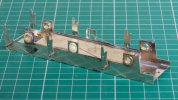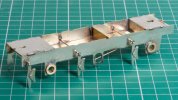Richard Gawler
Western Thunderer
I am using a micro flame torch instead of the iron wherever I can, and I am using far less solder and needing far less cleaning up afterwards. The torch was a good buy. I put the solder on the inside of the joint and apply the heat on the outside, and the flux does the rest of the work.
The 100 degree solder is intriguing. Apparently, when this forms an alloy with white metal the result has a higher melting point than either the solder or the white metal. There are places on my coping where the solder joint is well over 0.5 mm thick but I cannot see where the solder meets the coping. I never got the hang of chemistry, but the solder (Carr's) is 25% tin / 25% lead / 50% bismuth. I don't have a spec for the whitemetal.
At the moment, I am more interesting in trying to achieve a reasonable standard of construction than aiming for scale accuracy or correctness to prototype. So the copings are going to look overscale in thickness but I will be happy as long as they look neat and tidy.

I have got the footplate assembly underway and this looks as though it will sit flat under the body without tell-tale gaps. However I am going to have to move the guard irons inwards, otherwise they will foul the buffers (Markits).
The side frames are from the Alan Gibson kit for a Holden E4. These needed a lot of fettling, the oval cut outs looked as though the artwork had been hand-drawn, but I am happy with them now. I want to build the chassis and install the wheels before I add the castings for the axle boxes, to make sure the castings line up with the axles.
The 100 degree solder is intriguing. Apparently, when this forms an alloy with white metal the result has a higher melting point than either the solder or the white metal. There are places on my coping where the solder joint is well over 0.5 mm thick but I cannot see where the solder meets the coping. I never got the hang of chemistry, but the solder (Carr's) is 25% tin / 25% lead / 50% bismuth. I don't have a spec for the whitemetal.
At the moment, I am more interesting in trying to achieve a reasonable standard of construction than aiming for scale accuracy or correctness to prototype. So the copings are going to look overscale in thickness but I will be happy as long as they look neat and tidy.

I have got the footplate assembly underway and this looks as though it will sit flat under the body without tell-tale gaps. However I am going to have to move the guard irons inwards, otherwise they will foul the buffers (Markits).
The side frames are from the Alan Gibson kit for a Holden E4. These needed a lot of fettling, the oval cut outs looked as though the artwork had been hand-drawn, but I am happy with them now. I want to build the chassis and install the wheels before I add the castings for the axle boxes, to make sure the castings line up with the axles.








